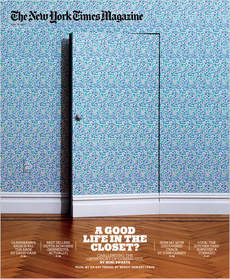Closet therapy
 The latest cover of the New York Times Magazine looks at religion, gay orientation/identity, and therapy, and the reporting from Mimi Swartz is pretty straight forward. However, there were a few strange elements in the piece, especially the headline, "Living the Good Lie." The piece looks at how therapists are trying to deal with how to affirm a client's sexual identity while acknowledging religious beliefs that might condemn homosexual behavior. There's nothing that explores that people are "living a good lie" since as far as I can tell, the therapists are encouraging their clients to acknowledge and even tell their significant others about their orientation/identities.
The latest cover of the New York Times Magazine looks at religion, gay orientation/identity, and therapy, and the reporting from Mimi Swartz is pretty straight forward. However, there were a few strange elements in the piece, especially the headline, "Living the Good Lie." The piece looks at how therapists are trying to deal with how to affirm a client's sexual identity while acknowledging religious beliefs that might condemn homosexual behavior. There's nothing that explores that people are "living a good lie" since as far as I can tell, the therapists are encouraging their clients to acknowledge and even tell their significant others about their orientation/identities.
Also, let's look at this strange paragraph LeBlanc style for a minute.
Christians of the kind who earnestly believed that the Bible deplored homosexuality were particularly troubled as they tried to reconcile their faith with their sexual orientation. The more Flanigan studied this conundrum, the more he came to see it as intractable. Some gay evangelicals truly believe that to follow their sexual orientation means abandonment by a church that provides them with emotional and social sustenance — not to mention eternal damnation. Keeping their sexual orientation a secret, however, means giving up any opportunity to have fulfilling relationships as gay men and women.
There's something weird about the clause "Christians of the kind who earnestly believed ..." as though they are a species in the zoo to be examined. Further, do gay evangelicals believe that churches would particularly pinpoint sex as the specific key for "eternal damnation" or is that just an expression?
The reporter doesn't dive too far into the whole "conversion therapy," when some tend to simplify, but the following paragraph could be confusing to those who don't know much about it.
As Katz wrote in “Gay American History,” gay men and lesbians “were long subjected to a varied, often horrifying list of ‘cures’ at the hands of psychiatric-psychological professionals.” These included lobotomies, castration, hysterectomy, clitoridectomy, hormone therapy, LSD, sexual stimulants, sexual depressants, shock treatment, aversion therapy, electroshock and so on. That changed, of course, as mainstream attitudes about sexual orientation changed. But even as Flanigan was beginning his professional life as a counselor in the late 1990s, groups on the religious right, like Narth (then called the National Association of Research and Treatment of Homosexuality) and Exodus International were advertising that they could cure homosexuality.
 We're back to the "cure" word again.
We're back to the "cure" word again.
If you don't know much about Narth or Exodus, you might conclude that they engage in the more drastic therapies mentioned right before the references to the actual organizations. Perhaps the piece could have used a sentence or two explaining how they try to "cure homosexuality" and then explain the American Psychological Association has outlined. Then again, the story could also mention that these groups reject the "cure" label and insist that this word is too simplistic.
Obviously, I realize you can't include everything. Nevertheless, in a 6,000 news piece, this crucial subject might deserve a little more explanation.
As a whole, the piece did a nice job for what the writer set out to do, as she focuses mostly on the interviewees' experiences and words. The basic gist is that therapists in the piece seek to embrace the client's sexual orientation without necessarily forcing him or her to identify as being gay.
The American Psychological Association has said, "Acceptance of same-sex sexual attractions and sexual orientation may not mean the formation of an L.G.B. sexual-orientation identity; alternate identities may develop instead." For example, a therapist might accept a client's sexual orientation as gay, while acknowledging their sexual identity as being straight. Overall, the story does a pretty nice job of dealing with the complexities of the potentially explosive topics of religion, sexuality and therapy.